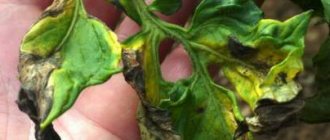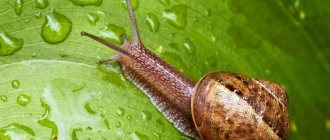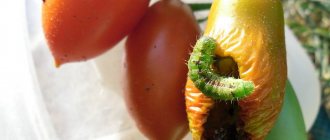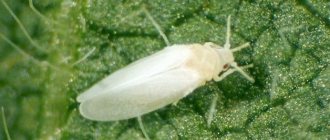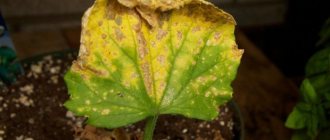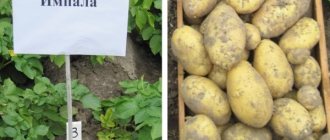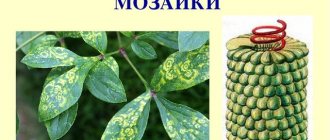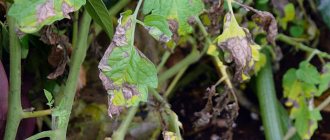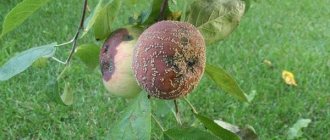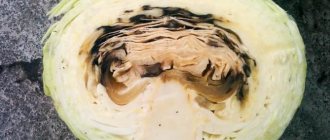Vegetable growing » Cabbage
0
1438
Article rating
Kira Stoletova
One of the most annoying garden pests is aphids. It especially likes to attack the leaves of young cabbage. These pests multiply quickly and manage to cause damage to the crop in a short time - treatment of cabbage against aphids must be timely.
Treating cabbage against aphids
How to recognize aphids?
Aphids are an invisible but dangerous insect that feeds on plant sap. It can be recognized by the following external characteristics:
- the body is translucent, egg-shaped and short in length - about 2.2-2.5 mm;
- the color of the body is pale green, often appearing gray due to a waxy coating, with brown transverse torn stripes that begin from the first element of the abdomen;
- the head is brown with black eyes and short antennae consisting of 5-6 segments;
- the oral apparatus is small and designed like a proboscis, piercing the integumentary tissues of leaves and drawing out juice from them;
- the tail is conical, dark green in color and without marginal tubercles;
- the legs are brown, as are the cylindrical tubes, which are slightly swollen in the middle and slightly shorter than the tail.
Such pests can often be found on representatives of cruciferous plants, which include not only all types of cabbage, but also the following crops:
- daikon;
- turnip;
- radish;
- radish.
The pest reproduces quickly, since the birth of offspring occurs without fertilization, and one female can lay up to 40-50 larvae. Moreover, about 15-20 generations of this pest change during the season.
In spring and summer, only female insects are born. Males are born in the fall, when females lay eggs on cabbage heads or other cruciferous plants left over for the winter. They winter well if the plants are under snow. In the spring, when the air temperature reaches +11-12°C, the larvae hatch from the eggs, and their life cycle repeats. Females without wings appear after several lines, after about half a month. They do not need males for fertilization, and each of them is capable of producing up to half a hundred larvae.
Preventive actions
After planting seedlings in open ground, it is important to prevent the spread of pests. The phenocalendar, a graphic representation of the life cycle of insects, helps in this work. It allows you to determine the period of maximum harm and the time of treatment.
Tips for preventing aphids from breeding on cabbage:
- To repel pests, you can place fragrant herbs and garlic arrows around the beds, or plant marigolds, tansy, and wormwood in the garden next to cabbage.
- It is advisable to observe crop rotation on the site. The predecessors of cabbage should not be other plants from the cruciferous family.
- After harvesting, it is necessary to destroy all plant debris. Carefully remove the stems and roots of weeds and cut cabbage heads, dig up the soil using a spade.
Young seedlings are fed with complex mineral preparations. Avoid excess nitrogen in fertilizers and soil, which aphids love. Strong plants are better able to resist pest attacks. It is important not to miss the moment when aphids appear in the spring. Having destroyed the first generation of insects, you can forget about them for a while, if there are no infected gardens and orchards nearby.
Causes of aphids
In most cases, aphids appear on plants after females accidentally fly into the garden in the spring and lay eggs in the weeds, from which many larvae hatch after winter. This will be the beginning of the insect’s reproduction mechanism.
In addition, ants can spread aphids. They coexist very closely with this pest, since aphids secrete tasty food for them - sweet-tasting honeydew. Thus, ants keep aphid eggs in their anthills even in winter, and in the spring they take them out to the site and spread them over young plants.
If cabbage is infested with aphids, many black ants can often be found on it or near the plantings.
Signs of cabbage damage
Aphids reproduce very quickly, so the sooner they are detected, the better. This can be done by regularly inspecting the cabbage leaves. If the pest has already attacked the cabbage, then this will be indicated by the following signs:
- the leaves become discolored, especially at the top, fade and become more fragile;
- the area between the veins on the leaf blades seems to be decaying and gradually begins to dry out;
- the plant gradually loses its green color, becomes covered with yellow spots and dries out, as it loses chlorophyll and becomes unable to fully carry out photosynthesis;
- cabbage grows poorly because it absorbs nutrients extremely slowly and at the same time quickly loses its vital juices;
- a sticky dirty coating appears on the plant, which is a waste product of parasites;
- with severe damage, the leaves curl into tubes and become deformed, and heads of cabbage do not form.
When inspecting cabbage for the presence of aphids, you need to take into account that the pest initially multiplies on the lower part of the bushes, and over time it spreads to the entire plant.
With severe damage, accumulations of aphids can be seen even with a superficial examination of the cabbage.
There are aphids on cabbage: what is the danger?
Insect pests feed on cabbage juice, and the crop weakens.
In a plant deprived of nutrients, all vital processes are disrupted. Growth and development are inhibited, and as a result, the culture simply dies. As they multiply, aphids create entire colonies on cabbage, and this entire horde destroys both the cabbage and the plants growing nearby.
Attention!
According to statistics, early-ripening cabbage varieties are affected four percent more than late-ripening varieties. It is especially important to monitor the seedlings.
Why are aphids dangerous?
The danger of aphids for cabbage lies in the fact that it multiplies quickly, sucks the vital juices from the crop and provokes disruptions in its vital functions, which is why the vegetable develops poorly and dies.
In addition, aphids can infect the plant with various fungal and viral diseases, including:
- mosaic;
- black ring spot;
- necrotic jaundice, etc.
The fact is that aphids are capable of transmitting various diseases from diseased plants to healthy ones. So, if there is a diseased plant in the garden, colonies of insects will quickly spread pathogenic microflora, so other garden plants growing in the neighborhood will also suffer.
Pest-resistant cabbage varieties
Breeders are working hard to create new cabbage hybrids that are resistant to various insect pests. Gardeners should adopt the following varieties:
- The aggressor is late-ripening white cabbage of Dutch selection. It is frost-resistant, but the main advantage of the hybrid is that it is almost not attacked by insects.
- Amager 611. This cabbage variety has already won the trust of gardeners. It also belongs to the late ones. The advantages of the hybrid are resistance to diseases and pests, high yield and good shelf life.
- Bartolo - bred by Dutch breeders, a late-ripening variety. Almost not susceptible to clubroot and fusarium, resistant to pests, high-yielding.
Why is it difficult to control aphids?
Getting rid of aphids is not so easy, since predatory insects refuse to peck them. The fact is that when absorbing cabbage juices, aphids accumulate glucosinolate in the body, and a fermented substance, myrosinase, appears in its muscles. When a predator attacks an aphid, it begins to secrete these enzymes, which are converted into mustard oil - a real poison for birds. As a result, the predators either die or escape.
Even ladybugs that prey on aphids either die after a while due to mustard oil or crawl away from the colonies.
Meanwhile, the aphidius larva copes with aphids. It lives in the insect's body, causing it to swell into a ball, turn brown, stick to the leaf and die. It is known that the breeding of such larvae is carried out in special laboratories, so ordinary gardeners often do not have access to them. However, there are other ways to combat cabbage pests, which can be found below.
Getting rid of cabbage aphids using folk methods
Aphids on cabbage are not a major pest, but even despite their modest size, they pose an impressive danger to cabbage. Various insecticides are undoubtedly effective means against aphids, since not only insects die, but also larvae. However, chemicals can accumulate in the heads of cabbage themselves, and thereby harm your body. And since all cabbage is consumed as food, insecticides become even more dangerous.
aphids on cabbage
The most harmless methods against aphids are folk ones. There are quite a large number of them, so you can choose the most effective method specifically for your case. Let's move on to the most popular of them.
Tar soap.
This soap contains birch tar. It is this component that is destructive not only for aphid colonies, but also for ants, which act as carriers of this very aphid.
The most popular recipe for a solution based on this component is the following: add one hundred and fifty grams of tar soap to ten liters of water. By treating your cabbage plantings with this product, you will not only get rid of aphids, but also help the leaves of your plants recover. The wounds on the plants begin to heal, and the aphids, which cannot tolerate the pungent smell of such soap, will leave your plantings. This procedure must be repeated seven days later.
Bay leaf.
This is also a popular method among gardeners to combat aphids. This spice contains a lot of essential oil, the smell of which repels aphids. This component is the main one both in dry formulations and in the form of infusions.
You can place dry bay leaves under the bushes in your garden bed. Or you can prepare an infusion. To do this, pour ten grams of bay leaves into a liter of hot water. You need to let it sit for about an hour with the lid closed. Repeat the procedure after five to six days.
Ammonia.
Ammonia is suitable as a means of getting rid of aphids. It is usually used in the form of an infusion. To do this, mix fifty milliliters of ammonia with ten liters of water. You also need to grate laundry soap using a coarse grater and leave it in a little warm water. Add soap to the solution. By the way, laundry soap is sometimes replaced with shampoo or dish soap. During the growing season, this solution is used more than once. The interval between applications should be about seven days.
If you use this method of combating aphids, then do not forget about your own safety measures. Be sure to wear a respirator or mask to protect your respiratory tract. You should wear rubber gloves on your hands. The preparation of such a solution must take place outdoors. This mixture should be stored in a place that children do not have access to.
Methods for controlling aphids
After discovering aphids in your garden plot, you must immediately begin to combat them. In this case, it is advisable to immediately apply several methods, each of which will be considered separately.
Biological and mechanical methods
It is proposed to breed birds and insects on the site, which can destroy this pest before it turns into an adult insect.
For these purposes, you need to attract the following birds to the cabbage patch:
- tits;
- warbler;
- linnets;
- Vorobyov.
To do this, you need to install special feeders filled with grain crops:
- sunflower seeds;
- millet;
- millet;
- oats
Tits will also be happy with hung unsalted lard, hard-boiled eggs, and grained cottage cheese.
Among insects, it is better to attract those individuals that are able to cope with aphid larvae. These include:
- Ladybugs . They can be attracted by installing log houses with holes for wintering on the site. This method is relevant for southern areas where winters are warm. In other regions, to attract ladybugs in the garden, it is better to plant the following plants: yarrow;
- tansy;
- buckwheat;
- dill;
- angelica;
- sweet clover
In order to repel aphids, you can also plant spicy plants on the site, in particular:
- basil;
- mint;
- garlic;
- onion;
- fennel;
- lavender.
Some experienced gardeners sow tobacco between the beds, as it destroys cabbage caterpillars and aphids.
These methods are acceptable in the early stages of cabbage infestation by aphids, when it is still in the form of a larva. In case of a large pest invasion, they are ineffective, so they will have to be combined with the use of chemicals.
Physical way
Acceptable at the stage when there are still few pests in the garden. In this case there is no need to use chemicals. The method is to destroy aphids with your own hands. To do this, the beds must be carefully inspected, and any identified pests must be crushed directly on the cabbage.
Chemical method
The most reliable and effective method of combating aphids, which involves treating cabbage with biologically active preparations and chemical insecticides. Popular means include:
- Pyrethrum . Biological preparation in powder form based on chamomile. Before processing, it must be diluted in water at the rate of 60 g per 10 liters of liquid. Spray cabbage with it in calm weather once every 2 weeks throughout the vegetable growing season.
- Karbofos . A toxic but very effective broad-spectrum remedy that helps get rid of adult pests and larvae. The insecticide must be diluted in water at the rate of 7.5 g per 5 liters. When spraying plants, wear equipment (respirator, rubber gloves). The weather should be dry, without gusty winds. Use the drug 1 time. After treating cabbage, the parasites will die within 2 hours, and the protective effect will last for 20 days or more, depending on weather conditions.
- Seifos . Not as poisonous as Karbofos. It is more often used in cases where the seedlings were not treated before planting in a permanent place. The plant should be sprayed with a solution of 5 g of product per 5 liters of water. After spraying, the aphids disappear within 2-3 days.
- Spark . The insecticide is sold in several variations, so its packaging may have the prefix “Gold”, “Bio” or “Double effect”. Available in powder, tablet or liquid form. Before use, the drug must be diluted in water according to the instructions on the package. After treatment, plant protection lasts about 3 weeks. To consolidate the effect, it can be re-applied after 15 days, and then once a month throughout the growing season. The last treatment should be carried out at least 20 days before harvest.
- Deltamethrin . A broad-spectrum insecticidal drug that can immediately destroy pests, since it blocks the transmission of nerve impulses in them, which leads to their paralysis and death. It is harmless to humans, as it contains only natural ingredients. It begins to act immediately after processing the cabbage and over the next 20 days.
Other drugs based on deltamethrin are also produced, including Decis pro, Fas and Atom.
To prevent aphids from getting used to chemicals, they need to be changed annually. Although their use allows you to quickly get rid of pests, they still pose a danger to the vegetable, so after processing the cabbage should be fed with natural fertilizers.
There are products that simultaneously destroy aphids and feed cabbage. You can learn about one of them from the video below:
Traditional methods
Not all gardeners like chemical treatment of plants. Many people prefer to use folk remedies that do not have a toxic effect. These include:
- Water supplied under pressure . You can get rid of aphids using water supplied through a hose. This creates pressure, causing insects to be washed off the plants. The aphids can no longer crawl back. If you shower frequently, you can gradually get rid of these insects.
- Soap solution . Prepared from laundry or tar soap. For 10 liters of water you need to take 100 g of soap. Spray the heads and legs with the prepared mixture from a spray bottle.
- A mixture of soap and soda . Dilute 1 tbsp in 10 liters. l. soda ash and 1/2 bar of laundry soap, grated on a fine grater. Spray the mixture onto the cabbage.
If you use only soda, it will not linger on the leaves and will quickly be washed away by rain, so it is supplemented with soap.
- Infusion of ash . For a 10-liter bucket of water, take 2 cups of wood ash. Mix the mixture thoroughly and apply it to the cabbage leaves. The ash can also be used in combination with cinnamon and pepper (red and black). Spices need to be mixed in equal proportions and add 200 g of wood ash. Separately, dilute 200 g of laundry soap in 1 liter of warm water, add the finished powder and 9 liters of cool water. Mix the composition thoroughly and use as directed 2 times with intervals of 3 days. For preventative purposes, cabbage can be processed once a month.
- Tobacco decoction . To prepare a concentrated product, you need to grind 10 g of dry tobacco, add 5 liters of water and leave for 24 hours. Next, boil the composition for 2 hours over low heat, after adding another 5 liters of water. Treat cabbage with broth from a watering can or spray bottle.
- Orange peel decoction . Take 2 cups of crushed and dried orange peels, pour warm water over them and leave for 24 hours. Then boil the composition for about 10-15 minutes, strain and dilute with 10 liters of water. At the end, add 100 g of soap and use as directed.
- Spicy infusion . Prepare garlic, horseradish (leaves or roots) and hot pepper. Grind the horseradish, fill the pan a third with it and pour boiling water over it. Leave until the water cools down. Take 2 pods of hot pepper and a head of garlic, finely chop and pour 1 liter of boiled water. Then pour this solution into the pan with horseradish. Before treating plants, add a little liquid soap.
- Infusion of celandine . Take 4 kg of raw or 1 kg of dry herb, pour 10 liters of hot water and leave for 24 hours. Strain the composition, add a little liquid soap and use as intended.
- Infusion of potato or tomato tops . Finely chop fresh tomato or potato tops. You can take both in equal parts. Fill the pan halfway with the prepared raw materials and pour in boiled water. Leave for 24 hours, strain and add a little soap. Treat cabbage with the prepared mixture.
- Sorrel infusion . Aphids do not like the sour infusion of horse sorrel. To prepare it, dig up the roots of the plant, chop it and pour boiling water at the rate of 150 g per 5 liters of water. Leave for 24 hours and use to spray affected plants.
- Dandelion infusion . Dig up dandelion roots (200 g) and collect leaves (500 g). Grind the raw materials and leave for about 3 hours in boiling water. Strain the mixture, add liquid soap and treat the cabbage with it.
- Chamomile infusion . To prepare it, take 100 g of dry raw materials, pour 1 liter of boiling water and leave for 12 hours. Strain the infusion, pour in 2 liters of water, add a little soap and spray the plants with it.
- Infusion of onion peels and onions . Take 2 onions and some onion peels. Chop the onion, combine with the peel and add 2 liters of hot water. Leave for about 4 hours, add soap and use as directed.
- Infusion of pine needles . Prepared within 1 week. Take 1 kg of pine needles and pour 4 liters of boiled water. Leave for a week, stirring the needle daily. Before using the infusion, dilute it with water in equal proportions.
- Vinegar . Repels insects with its pungent odor. You need to take 1 tbsp. l. essences and dilute in 10 liters of water. It is enough to treat cabbage with the product 2 times to completely get rid of aphids.
- Mustard . To treat affected leaves, you can prepare a solution of 50 g of powder per 5 liters of water. In addition, dry mustard should be scattered near anthills, because ants are distributors of aphids.
- Essential oils . In the fight against aphids on cabbage, the use of essential oils - tea tree, lavender, thyme, cedar - shows excellent results. 10 drops of each product should be diluted in 0.5 liters of water and sprayed with the composition on each cabbage leaf. Processing should be done in the evening.
- Ammonia . Like vinegar, it repels insects with its pungent reserve. Helps get rid of even adult aphids. In 10 liters of water you need to stir 50 ml of ammonia and pour the cabbage from a watering can.
You can use an alcohol solution no more than once every 14 days, otherwise excess nitrogen will lead to deformation of the leaves and impaired growth of the vegetable.
How to treat cabbage with an effective folk remedy based on ammonia is described in the video below:
Prevention: how to protect crops from aphids
Prevention of cabbage from diseases and pests is simple: compliance with crop rotation and proper care.
All cruciferous vegetables have the same pests; when planting, choose the right predecessors; for cabbage, these are onions, carrots, and legumes.
Aphids on cabbage may appear due to poor nutrition of the plant; before treating with fertilizer, make sure that the dosage of fertilizer corresponds to the instructions. After harvesting, the soil should be thoroughly cleaned of plant residues; aphid eggs overwinter in cabbage stalks and weed residues. – a very healthy and tasty product, a storehouse of vitamin C.
It is healthy and tasty both fresh and after processing (in hot dishes), in winter preparations. To protect crops from aphids, start preventive measures in advance, since aphids reproduce almost continuously.
Simple folk remedies will help you get rid of uninvited guests.
Protection against cruciferous flea beetle
Cruciferous flea beetles are small bugs that damage leaves by gnawing out the pulp in them in the form of small round spots along the edge of the leaf. They damage seedlings, seedlings, and seeds after planting.
Dilute 1 tablespoon of 70% table vinegar in 10 liters of water. Spray the plants (usually once is enough).
A good and at the same time environmentally friendly remedy for cabbage pests is pollination with ash sifted through a sieve.
Plant leaf or head lettuce in the spaces between cabbage rows to prevent the appearance of cruciferous flea beetle.
Protection against gray aphids
Gray aphids are small light-colored insects that feed on cabbage juice, almost merging in color with cabbage leaves. The outer leaves become pinkish, thin and curl.
Protection: - using a foam sponge, coat the cabbage with foam of laundry soap; — dilute half a liter of milk and 10 drops of iodine in a bucket of water, spray the cabbage with this solution; - spray with a decoction or infusion of potato or tomato tops; — ash-soap solution (see below); - herbal infusions with a pungent odor: infusions of garlic, onion, tobacco.
Environmentally friendly measures to combat cabbage whites
In July-August, large, yellow-green caterpillars with black dots and yellow stripes appear on cabbage plants, which eat the leaves, starting from the edges, leaving large veins.
Inspect the underside of the leaves daily and remove egg laying with a damp swab.
It has been noticed that the cabbage white butterfly does not lay eggs on a dirty, rough leaf or on cabbage with a strange smell, so if you spray it with an ash-soap solution, weed infusion, garlic or onion infusion, the butterfly will fly around your cabbage.
Burdock infusion: chop the burdock (you can use all parts of the plant) and fill the container with it to 2/3 of the volume, add water to the top. Infuse for a week. Then dilute 1 liter of infusion in 10 liters of water and spray the cabbage. Treatment should be carried out after 1-2 weeks, depending on the appearance of butterflies.
Against aphids and caterpillars on cabbage
Ash infusion: pour 1 glass of ash into 10 liters of cold water, stir and leave until morning. In the morning, stir and strain. Spray the plants early in the morning, about 6 o'clock, before the start of butterfly flight, as often as possible, covering the lower part of the leaves.
Protection against cabbage moth
Cabbage moth caterpillars damage cabbage in June-July, gnawing out the pulp in the leaves, where small windows are formed, penetrate inside the young head of cabbage, and spoil it.
Dusting with wood ash helps tame the pest.
Protection against cabbage cutworm
Caterpillars in cabbage cutworms are green when young, then brownish-brown with a pattern of slashes on their backs. They gnaw large through holes in the head of cabbage and spoil it with excrement. Control measures against these caterpillars are the same as against cabbage moths.
In your personal garden, you can collect and destroy them without using poisons.
Protection against cabbage fly
The cabbage fly begins to lay eggs directly on the soil in the second half of May, causing the greatest harm to seedlings planted in open ground. The larva gnaws through the base of the stem and root, destroying the plant. Particularly significant damage is caused in wet weather (in a dry year, the egg dries out on the soil or the larva dies).
To combat this pest, it is recommended to rake the soil away from the cabbage and pour salt water over the plant itself (1 glass of salt per 10 liters of water). Sprinkle the soil around the stem with wood ash.
In addition, non-chemical preparations from soil microorganisms can be used. The drug is absorbed by the plant and protects against any pests for about three weeks, causing paralysis of the digestive system.
A solution of yeast mash gets rid of many pests, which also acts as root and foliar feeding when growing cabbage.
A universal remedy against pests is wood ash - it is used to pollinate cabbage, as well as for spraying in the form of infusions against almost all pests.
And the most reliable and environmentally friendly means of protecting cabbage from pests is to cover the cabbage beds with non-woven material, carefully caulking all the cracks.
It's not just people who love cabbage. If you don't protect your garden, succulent forks can be eaten by cows, goats, mice, rats, hares and rabbits. Usually, in dachas and rural areas, reliable fences are installed that large animals cannot get through. But small pests are not afraid of such barriers; they will penetrate into any hole.
Your plantings may be attacked by:
- slugs;
- cruciferous flea beetle;
- cabbage fly, midges;
- thrips;
- bedbugs;
- mites;
- caterpillars.
You won't see thrips; they are very small and live in the ground. You can tell that they have attacked the cabbage by the dried leaves that resemble cobwebs. Some summer residents believe that beautiful bugs, which children call “firemen” or “soldiers,” are not dangerous for planting. This opinion is wrong - cruciferous bugs really love cabbage juice and sometimes lead to dehydration of all the plants in the garden. If you notice that the cabbage is full of holes, it means that the cruciferous flea beetle has attacked the plants.
Flies, moths and butterflies do not feed on plants as adults, but they lay eggs from which larvae and caterpillars hatch. Voracious insects need to quickly gain enough mass to turn into a cocoon and then into an adult. If you do not destroy the masonry, you will not see a harvest; only dried stems will remain in the garden. Females are very cunning; they hide larvae in the most inconspicuous places. If you see fluttering insects, carefully examine each leaf, and then spray the garden bed with natural or chemical insecticides against cabbage flies.
You have been nurturing the seedlings all spring, protecting them from blackleg and other infections, but in the garden they found themselves face to face with a huge number of dangers. Your task is to help your green pets protect themselves from all troubles and grow up strong and healthy. It has been noticed that healthy, well-developed plants do not get sick and pests avoid them. Provide young plantings with good care, protect them from all misfortunes until they take root and become stronger.
Prevention
There are a number of preventive measures that will help protect your garden from aphids:
- in late autumn, completely clear the area from the remains of vegetable crops, dry them and burn them, and do not keep them in the garden;
- in the fall, carefully dig up the soil to a depth of at least 25 cm;
- fight weeds in a timely manner, removing them from all paths;
- use mixed planting technology, planting herbs and tobacco near the cabbage bed;
- follow the rules of crop rotation, planting cabbage after carrots, onions and legumes;
- pay special attention to fertilizing cabbage, since aphids appear on weak young plants that are not fertilized enough.
Preventive measures against aphids
It is easier to prevent an aphid invasion than to fight it on the site. The following measures will help protect your garden from insect attacks:
- In autumn, all plant debris is removed from the beds, because insect eggs may remain on them.
- Plants and fruits on which aphid colonies are found are burned, and the soil is dug up to a depth of 15–20 cm.
- All weeds growing around the site must also be removed.
- In the spring, when sowing crops and planting seedlings in beds, it is necessary to strictly follow the rules of agricultural technology, which will allow you to grow healthy plants. It is known that aphids and other pests primarily attack weakened crops.
Practice has shown that most gardeners use folk remedies in the fight against aphids and other insects that attack the site. They are absolutely safe for humans, but effective against pests. After using them, you rarely have to use chemicals.
Mistakes of inexperienced gardeners
The most common mistakes that can lead to the spread of aphids are:
- Violation of landing rules . If you do not maintain the optimal distance between plants, apply fertilizers at the wrong time and improperly water the seedlings, the plants will turn out weakened and will attract the attention of insects.
- Chemical abuse . They destroy not only aphids, but also insects that prey on them. It turns out that such treatment harms the plants. It is necessary to use chemicals only when there are too many aphids and they can completely destroy the entire crop.
- Preservation of aphid eggs . Many gardeners do not remove stalks and weeds in the fall, so the eggs laid on them remain overwintering in the garden bed, and the larvae hatch in the spring.
Aphids are small-looking insects that can destroy large cabbage crops. It is important to start combating the pest in a timely manner, and even better, to prevent its appearance by observing preventive measures. It is also important to follow agricultural techniques for growing and caring for cabbage.
0
0
Copy link
